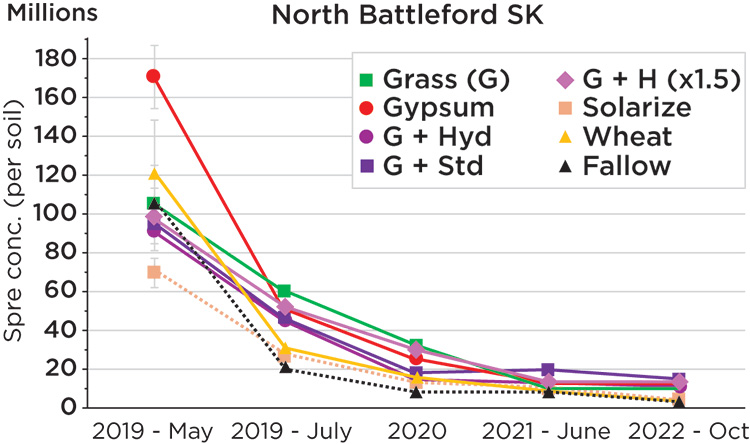Crop rotation reduces clubroot risk
KEY RESULT:
The treatments (liming, grassing, gypsum) did not consistently have a measurable effect on spore concentrations relative to the bare soil control. The best clubroot management practices remain rotation breaks between host canola crops and the use of resistant cultivars.
PROJECT NAME, PRINCIPAL INVESTIGATOR:
“Managing small patches of clubroot infestation in canola fields” Bruce D. Gossen, Tim Dumonceaux, Agriculture and Agri-Food Canada Saskatoon; Mary Ruth McDonald, University of Guelph
FUNDING:
SaskOilseeds, Manitoba Canola Growers, DL Seeds,
Manitoba Agriculture, Graymont
Genetic resistance is effective against clubroot but can break down quickly. Plant breeders are also falling behind in developing cultivars resistant to the many newer clubroot pathotypes. As a result, farmers need effective ways to manage clubroot in situations where genetic resistance is not yet available or where high spore numbers increase the risk of a breakdown in resistance.
Researchers conducted this study to provide farmers with practical approaches to minimize the risk of clubroot spreading from small patches in newly infested fields. Their results are also applicable to managing hot spots of new pathotypes in fields where the pathogen is already established.
One of the first outputs of the study was an improved method to quantify the numbers of resting spores in soil using a molecular approach known as digital drop PCR (ddPCR). This approach was less expensive, more accurate and more robust than previous methods, so it was used throughout the study.
The study examined the effect of liming and grass cover crops on survival of resting spores of P. brassicae in short-term studies under controlled conditions and in commercial fields over several years.
Researchers conducted field-site experiments on a wide range
of soil types (clay, loam, sand) with a range of soil pH (5.5-7.0) at sites in Alberta, Saskatchewan and Manitoba.
Results
In short, the treatments (liming, grassing, gypsum) did not consistently have a measurable effect on spore concentrations relative to the bare soil control.
- Short-term dense planting of grass and cereal crops produced
a small reduction in resting spore concentration in infested soil. However, this effect was not detectable at field sites, regardless of soil type or pH. - Application of lime did not reduce spore numbers relative to the untreated control. The target pH for liming treatments was 7.5, but it was difficult to maintain that pH at sites with highly acidic soil.
- Long-term perennial grass cover crop on clubroot patches did not, on its own, reduce spores but did hold soil in place. This minimizes movement of infested soil by wind and water erosion as well as the risk of contaminating farm machinery and other vehicles driven across the infested patch.
In closing, this study strongly supports the recommendation that growers extend crop rotations in clubroot-infested fields to at least two to three years (longer is better) between susceptible crops. This allows the spore concentration in infested areas to fall, which reduces the risk of spreading spores and breakdown of resistance.
The study also confirmed that growers should always select resistant cultivars for use in infested fields, because high numbers of clubroot spores were almost always still present after five years of non-host crops.

Here are results from field trials at North Battleford. Interestingly, all of the sites had quite variable starting clubroot spore levels for each treatment. This is not a treatment effect. Gossen says this points to large differences in spore numbers within small areas. The key message is that years out of canola (time) is more important to reduce spores than any individual treatment. Grass mix only (G), grass and gypsum (Gypsum), grass and standard lime (G + Std), grass and hydrated lime (G + Hyd), grass and 1.5X hydrated lime (G + Hx1.5), wheat, solarization (which included two weeks under impermeable film), bare soil control (Fallow)




